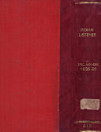AKASHVANI: Vol. XLV, No. 45 ( 19 OCTOBER, 1980 )
About this ebook
The Indian Listener (fortnightly programme journal of AIR in English) published by The Indian State Broadcasting Service, Bombay, started on 22 December, 1935 and was the successor to the Indian Radio Times in English, which was published beginning in July 16 of 1927. From 22 August ,1937 onwards, it used to published by All India Radio, New Delhi. From 1950,it was turned into a weekly journal. Later, The Indian listener became "Akashvani" (English ) w.e.f. January 5, 1958. It was made fortnightly journal again w.e.f July 1,1983.
NAME OF THE JOURNAL: AKASHVANI
LANGUAGE OF THE JOURNAL: English
DATE, MONTH & YEAR OF PUBLICATION: 19 OCTOBER, 1980
PERIODICITY OF THE JOURNAL: Weekly
NUMBER OF PAGES: 60
VOLUME NUMBER: Vol. XLV, No. 45
BROADCAST PROGRAMME SCHEDULE PUBLISHED (PAGE NOS): 7-24, 39-56
ARTICLE:
1.Building Machines With Human Attributes
2. My Source of Inspiration
3. Problems of Ageing And How To Face Them
4. What Kind of Teachers We Need
5. Assam's Bihoo Through The Ages
6. Harnessing The Brahmaputra River System
7. How Banks Can Play A More Effective Role
AUTHOR:
1. Prof. S. Sampath
2. Svetoslav Roerich
3. Dr. V. S. Natarajan
4. Dr. H. Visweswaran
5. Parag Chaliha
6. S. Dasgupta
7. R. Raghupathy
KEYWORDS :
1. Artificial organs , intelligence, man is superior
2. Spiritual values,wondrous world, beauty and perfection
3. Disabilities, mental disturbance, remedies
4. Qualities of a teacher,social responsibility,
5. Significance,, the songs an dances, downgrading and revival
6.Two major problems, link project, sharp focus
7. Crucial factors,policy emphasis
Document ID : APE-1980 (S-D) Vol-III-03
Prasar Bharati Archives has the copyright in all matters published in this “AKASHVANI” and other AIR journals. For reproduction previous permission is essential.
About the author
As India’s National Broadcaster and also the premier Public Service Broadcaster, All India Radio (AIR) has been serving to inform, educate and entertain the masses since it’s inception, truly living up to its motto – ‘Bahujan Hitaya : Bahujan Sukhaya’. One of the largest broadcasting organisations in the world in terms of the number of languages of broadcast, the spectrum of socio-economic and cultural diversity it serves, AIR’s home service comprises 479 stations , located across the country, reaching nearly 92% of the country’s area and 99.19% of the total population. AIR originates programming in 23 languages and 179 dialects.











